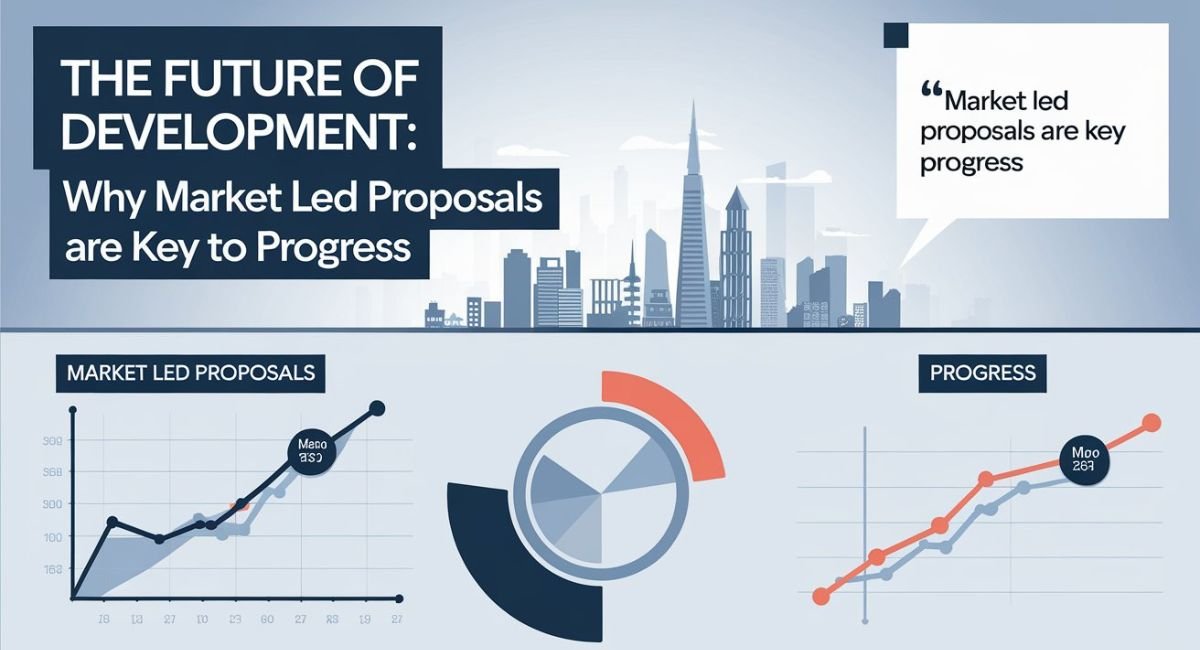Introduction
When analyzing directions for the future of urban and economic development, insights from market forces are becoming intimately associated with the process. These proposals build on the ability that private sector organizations have to solve public demands more efficiently and effectively. This way of approaching things, by focusing on market demand, glues the business operations’ sustainability and versatility to a number of parameters.
This means that the public sector needs to collaborate with private players to meet any future developments’ success. This change is driven by market led proposals.
Concepts put forward about market-led development are changing the ways cities and businesses evolve by adapting to program requirements all at once and with a view towards the future.
The Rise of Market-Led Proposals in Development
Market led proposals (MLPs) are currently emerging and quickly gaining ground over conventional MSDs, which are characterized by top-down government-implemented projects. Thus, this approach enables the private sector to take up innovative strategies for core development projects’ alignment with the market. Consequently, MLPs not only provide projects in a shorter period but also guarantee that they are appropriate in the served communities. This model is very important while managing the complexities and changes that are characteristic of the modern urban world.
How Market Led Proposals Promote Innovation
The core of market led proposals, therefore, is innovation. In contrast with conventional proposals that may experience organizational politics, MLPs encourage private companies to introduce new ideas and technologies. The competition for funding drives innovation. This leads to the development of excellent solutions for urban and environmental challenges. As cities grow and seek more space for expansion, market-driven and high-profile ideas offer better solutions. These solutions address how development can be achieved sustainably. Additionally, they ensure efficiency in urban growth.
- Encouraging Private Sector Creativity: The propositions put forward with the help of markets enable private businesses to suggest new ideas and advanced technologies, thus providing the necessary competition.
- Faster Implementation of Solutions: While the private sector takes a shorter time to implement solutions which are fine-tuned to market needs because there is less bureaucracy than in the public sector.
- Adaptability to Changing Needs: This makes a developer flexible to adapt to current market trends and challenges that may be unheard of at the time of project development to retain the future of the projects.
The Role of Public-Private Partnerships in MLPs
This is true because market-led proposals tend to be one of the most effective ways of developing a good PPP. Such relationships are crucial, for they meld together considerable resource capacities and competitive advantage on the part of business with considerable governance and regulatory capacity on the part of the state. The structure of the PPPs makes them commercially profitable while simultaneously addressing public needs, blending the business people’s profit-making objectives with the public interest. This saves time for the developers while at the same time ensuring that there is accountability.
Addressing Community Needs with Market Led Proposals
While profits mainly motivate market-led proposals, the ability of such projects determines the extent of benefit to the community. This implies that, through proper coordination with market needs, MLPs make developments like housing, infrastructure, and commercial projects relevant and necessary. MLPs actively work on these developments in a way that is more integrated into the community. This approach offers several tangible benefits, including job creation, enhanced public services, and economic growth. As a result, MLPs are becoming a more attractive alternative for addressing development needs.
Why Market-Led Proposals Are the Future of Development
It is for this reason that the idea of market-led proposals represent the future of development since it aligns with flexibility, optimisation and adaptability. Looking at the current problems such as urbanization or climate change, MLPs provide the way for flexible and adaptable development. Market-based approaches allow organizations in the private sector to bring about massive changes in a short span. These approaches work because they harness the knowledge of the private sector in addressing problems. This makes private organizations key stakeholders. As a result, they play a crucial role in determining the development of both urban and rural environments.
- Flexibility and Efficiency: Market led propositions conveniently align with market requirements and can deliver projects in shorter time frames compared to government-led concepts.
- Encourages Public-Private Collaboration: The incorporation of private sector knowledge with public supervision thus results in a healthy mix of development which not only encourages innovation but at the same time serves public interest.
- Sustainable and Market-Driven Growth: Due to the real-time nature of the market needs, MLPs are very suitable for development of projects in that they are relevant, sustainable economic developments.
FAQs
What are market-led proposals?
Market-led proposals are private sector-driven projects designed to meet public needs.
How do market-led proposals differ from traditional development?
They focus on market demand and private sector innovation, speeding up project completion.
Are market-led proposals more innovative?
Yes, they encourage creativity and competition, leading to cutting-edge solutions.
What role does the government play in MLPs?
Governments oversee regulation and provide frameworks to ensure public accountability.
Why are MLPs important for future development?
They offer adaptable, efficient, and sustainable solutions for growing cities and economies.
Conclusion
Market led proposals are the development model of the future, private initiative and public need. MLPs of this style build the right opportunity for private sector creation. They align with the needs of the community to create a dynamic vision for the future. This vision supports sustainable growth. The spirit of cooperation will remain critical as cities and economies progress into new paradigms. These paradigms reflect the issues of the future. Contextualizing market-led proposals is not optional in the complex and shifting nature of development – they are the solution.




